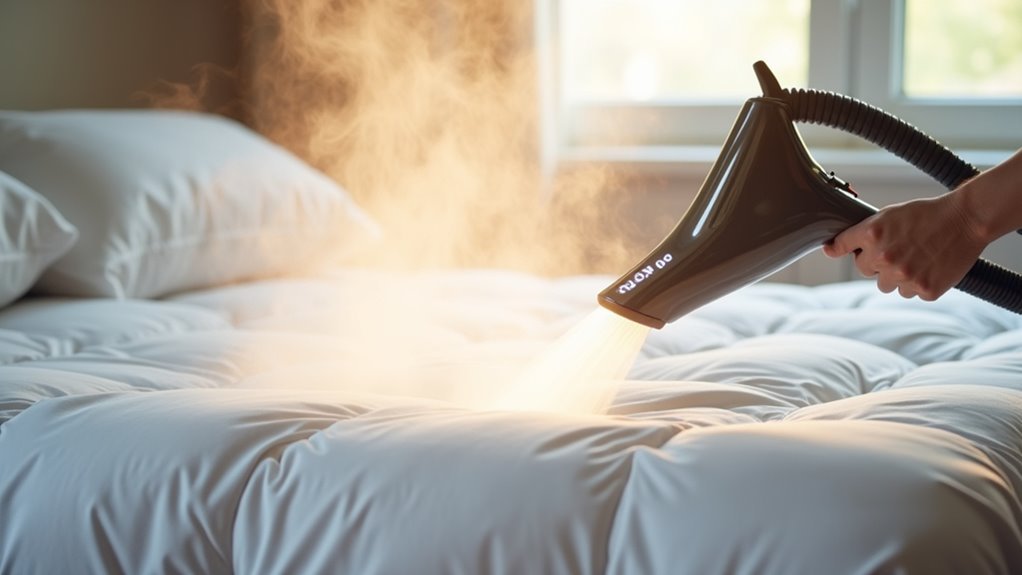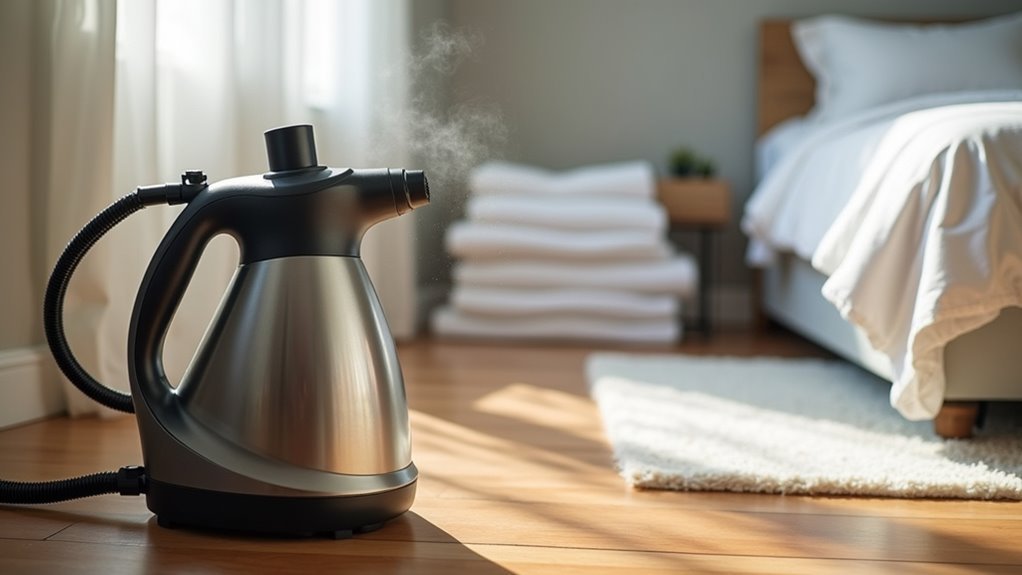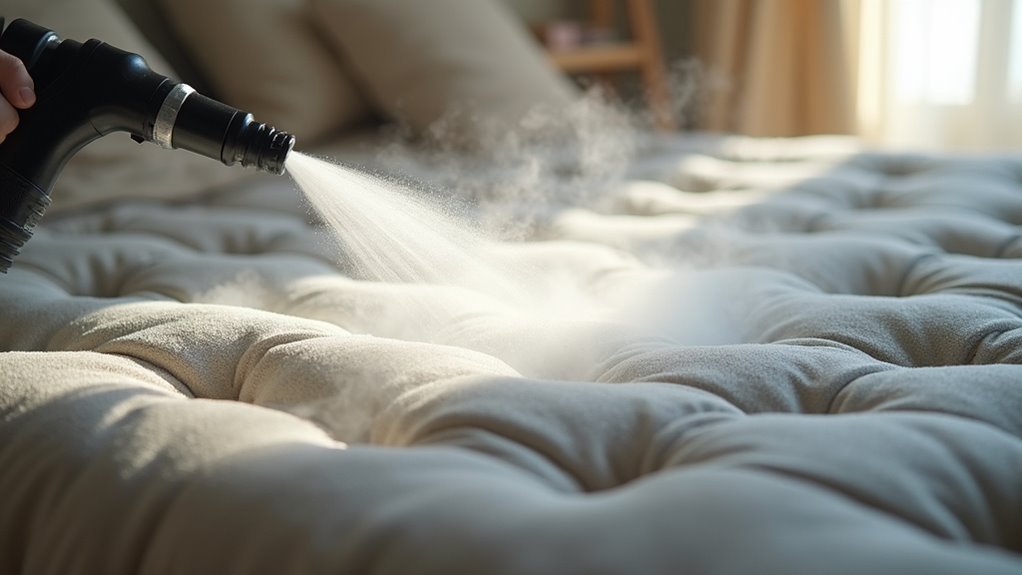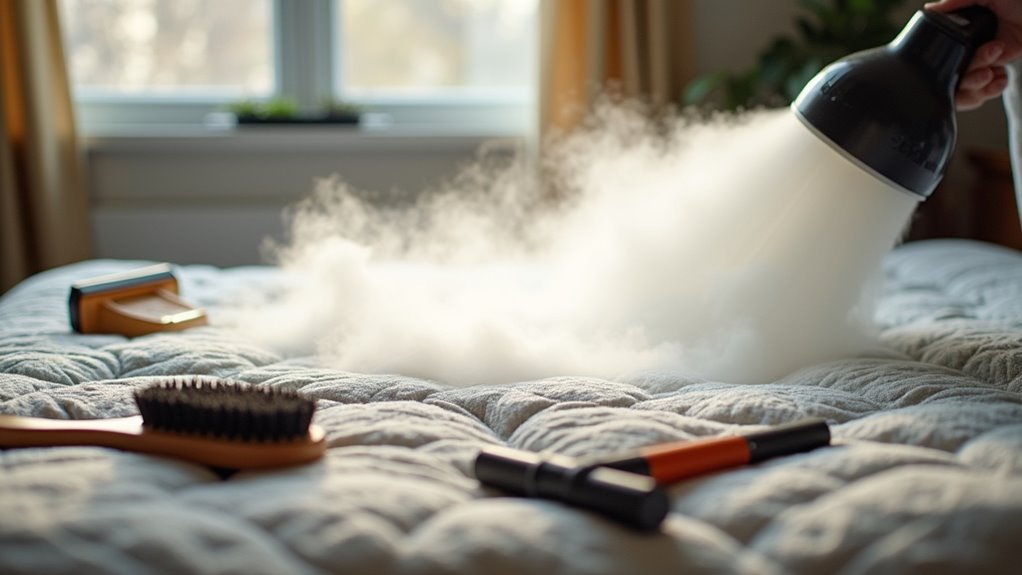You’ll eliminate bed bugs instantly by maintaining steam temperatures between 180°F-200°F on all surfaces. Use an industrial-grade steamer with a triangular nozzle, focusing on mattresses, box springs, baseboards, and cracks for 30 seconds each. Move the wand slowly at 12-inch distances, working from top to bottom in overlapping passes. Schedule follow-up treatments every 2-3 days to target newly hatched bugs. Combine with diatomaceous earth and essential oils for thorough control that guarantees complete eradication.
Understanding Steam Temperature Requirements for Bed Bug Elimination

When you’re battling bed bugs, understanding the precise temperature requirements for steam treatment can mean the difference between success and continued infestation.
Steam cleaning becomes most effective when temperatures reach 180°F to 200°F, killing bed bugs instantly on contact. However, you can still achieve results with a minimum threshold of 121°F for elimination.
Steam treatment requires 180°F to 200°F for instant bed bug elimination, though 121°F minimum can still achieve effective results.
To control bed bugs successfully, maintain surface temperatures between 160°F and 180°F during treatment. Use an infrared thermometer to monitor these critical temperatures accurately.
Position your steamer approximately 12 inches from surfaces, moving slowly to guarantee thorough coverage without creating excessive moisture.
For effective bed bug elimination, you’ll need multiple treatments spaced 2-3 days apart. This repetition targets newly hatched bugs and guarantees complete eradication of bed bug infestations throughout your home.
Selecting the Right Steam Cleaner Equipment for Maximum Effectiveness
Having the right temperature knowledge won’t help if your steam cleaner can’t deliver those critical heat levels consistently. You’ll need equipment that meets specific requirements for effective bed bugs control.
Your steam cleaner must reach temperatures between 180°F and 200°F with a minimum 1-gallon tank capacity. Don’t settle for clothing or carpet steamers—they won’t generate the high heat necessary for elimination. Instead, choose industrial-grade units that professional services rely on.
Essential features include:
- Triangular nozzle attachments for precise coverage in seams and corners
- Adjustable pressure settings to prevent surface damage while maintaining effectiveness
- Consistent temperature output throughout extended treatment sessions
These specifications guarantee you’re equipped to tackle infestations thoroughly without requiring multiple professional services visits.
Preparing Your Home and Steam Equipment Before Treatment

Before you begin steaming, proper preparation determines whether your treatment succeeds or fails. Start with a thorough inspection of your home, identifying bed bug hiding spots like mattress seams, box springs, and furniture crevices.
Move furniture away from walls to access all surfaces where these pests congregate.
Fill your steam cleaner’s tank with plain tap water—never use carpet or clothing steamers that won’t reach lethal temperatures for bed bug control.
Unplug all electronics in the treatment area to prevent electrical hazards during the steaming process.
Vacuum thoroughly before steaming, removing loose debris and visible bed bugs. This critical step enhances steam penetration and effectiveness.
Focus on preparing your home by ensuring all target areas are accessible and clear of obstructions that could interfere with proper steam application.
Targeting High-Risk Areas: Mattresses, Box Springs, and Upholstery
After completing your preparation, you’ll focus on the primary battlegrounds where bed bugs establish their strongholds: mattresses, box springs, and upholstered furniture.
Steam treatment becomes your most powerful weapon in these high-risk zones, delivering lethal temperatures of 180°-200°F that exceed bed bugs’ survival threshold of 121°F.
When targeting these areas, follow these essential techniques:
- Use a triangular nozzle on your steamer for ideal coverage, moving slowly through seams and crevices where bed bugs hide.
- Steam both sides of mattresses and box springs thoroughly, ensuring no spots are missed during treatment.
- Maintain 12 inches distance when steaming upholstery for 30 seconds over visible bed bugs to eliminate them without fabric damage.
Regular steam treatment combined with thorough inspections greatly reduces re-infestation risks in these critical areas.
Proper Steam Application Techniques and Movement Patterns

You’ll need to master three critical elements to effectively eliminate bed bugs with steam: controlling your wand’s movement speed, following systematic coverage patterns, and maintaining proper temperatures throughout treatment.
Move your steamer wand slowly at approximately 30 seconds per 12 inches while holding it about 12 inches from the surface to guarantee thorough penetration into hiding spots.
Start from the room’s highest point and work downward in overlapping passes, keeping steam temperatures between 180°F to 200°F for assured bed bug death on contact.
Steam Wand Movement Speed
Master the art of steam wand movement by maintaining a deliberate pace that allows heat to penetrate deeply into bed bug hiding spots.
You’ll need to move your steam wand slowly across surfaces, keeping it approximately 12 inches away while spending 30 seconds in each area to achieve effective heat penetration.
When targeting high-risk areas like mattresses and furniture seams, focus on these critical timing elements:
- Hold the steamer directly over any visible live bed bug for at least 30 seconds to kill bed bugs completely
- Maintain steady, deliberate movement to prevent creating wet spots that could lead to mold growth
- Keep consistent distance and speed across all treated surfaces for uniform heat distribution
This controlled approach guarantees the steam reaches the ideal temperature range of 160°F to 180°F necessary for elimination.
Surface Coverage Patterns
Strategic surface coverage patterns guarantee thorough bed bug elimination by preventing missed areas and treatment gaps.
You’ll want to start from the room’s highest point and systematically work downward, ensuring any dislodged bugs fall into areas you’ll treat next. Move the steamer slowly across surfaces, maintaining approximately 12 inches distance and spending 30 seconds per section for ideal heat penetration.
When you encounter visible bed bugs, hold the steamer directly over them for at least 30 seconds—steam can kill bed bugs effectively at 180°-200°F temperatures.
Use overlapping passes to create extensive surface coverage patterns, ensuring no gaps remain untreated. After steaming, surfaces should feel damp but not soaked.
This methodical approach delivers effective extermination by maximizing heat exposure throughout the infested area.
Temperature Maintenance Methods
While effective bed bug elimination depends on reaching lethal temperatures, maintaining consistent heat levels throughout your steaming process requires careful attention to equipment settings and application techniques.
Your temperature maintenance methods should focus on keeping steam between 180°F and 200°F consistently. You’ll need to monitor your equipment regularly and adjust settings as needed to prevent temperature drops that compromise pest control effectiveness.
- Use an infrared thermometer to verify surface temperatures reach 160°F to 180°F during application.
- Check your steamer’s gauge frequently and adjust heat settings when steam temperature begins falling below ideal ranges.
- Allow your equipment to reheat between room treatments to maintain consistent thermal output.
These monitoring techniques guarantee you’re delivering lethal heat levels that eliminate bed bugs effectively while avoiding the frustration of incomplete treatments.
Treating Baseboards, Cracks, and Hidden Bed Bug Hideouts
You’ll need to focus your steam treatment on baseboards, as bed bugs frequently shelter along these areas where walls meet floors.
Target every crack and crevice you can find, holding the steam nozzle close to guarantee the high temperature penetrates deep enough to kill hidden bed bugs and eggs.
Don’t forget to check behind furniture, under loose wallpaper, and around tacking strips where these pests love to hide from detection.
Steaming Baseboards Effectively
Because bed bugs often retreat to the narrow spaces where baseboards meet walls, you’ll need to target these areas with concentrated steam treatment. Set your steamer to at least 160°F to effectively kill bed bugs and their eggs lurking in these crevices.
Move the steamer wand slowly along each section, allowing steam to penetrate for approximately 30 seconds per area. Focus particularly on:
- Joints where baseboards connect to walls
- Gaps and cracks within the baseboard structure
- Corner areas where multiple surfaces meet
After steaming baseboards in the infested area, wipe away dead bugs and debris with paper towels, disposing of them in sealed plastic bags.
Make regular inspections part of your ongoing pest management strategy, as bed bugs reproduce rapidly and can quickly re-establish themselves without consistent monitoring.
Targeting Crack Infestations
Since bed bugs gravitate toward the smallest spaces where they can remain undetected, you must systematically target every crack, crevice, and joint throughout the infested room.
These effective techniques require precision and patience to eliminate bed bugs completely. Use a triangular nozzle attachment to direct steam treatment into narrow openings where standard nozzles can’t reach.
Maintain your steamer 12 inches from each surface while moving slowly along wall joints, furniture seams, and electrical outlets. The 180°-200°F heat will kill bugs and eggs instantly, but you’ll need to hold the steamer over each area for 30 seconds minimum.
Focus particularly on cracks and crevices behind bed frames, nightstands, and along carpet edges where bugs commonly nest.
Finding Hidden Hideouts
While walls and furniture receive most attention during bed bug treatment, baseboards and trim areas often harbor the largest concentrations of these pests.
Finding hidden hideouts requires a thorough inspection of these overlooked spaces where bed bugs thrive.
You’ll need to examine baseboards carefully for dark or rusty spots indicating bed bug excrement. These stains confirm active infestations in wall seams and furniture joints.
Focus your steam treatment on these areas using temperatures between 180°F and 200°F.
Key areas to target include:
- Electrical outlets and switch plates near sleeping areas
- Wall seams where baseboards meet flooring
- Cracks behind headboards and bed frames
Complete your treatment by sealing cracks with caulk or plaster, eliminating current hideouts while preventing future infestations.
Post-Steaming Procedures for Optimal Results and Safety
Although steaming effectively kills bed bugs on contact, your work isn’t finished once you’ve completed the initial treatment.
Post-steaming procedures are essential to prevent bed bugs from returning and keep your home protected.
After steaming, hold the device over any live bed bug for at least 30 seconds to guarantee complete elimination.
Use paper towels to immediately dispose of dead bugs and debris, preventing re-infestation.
Open windows and run fans to enhance air circulation, helping steamed items dry quickly and preventing mold growth.
You’ll need to repeat steaming 2-3 times within several days since bed bugs reproduce rapidly.
Maintaining a bed bug-free environment requires regular post-treatment inspections to catch potential re-infestations early and guarantee long-term success.
Monitoring Surface Temperature and Moisture Levels During Treatment
You’ll need to track both temperature and moisture levels during steaming to guarantee you’re killing bed bugs effectively without creating new problems.
Use an infrared thermometer to confirm surface temperatures reach the critical 160°F to 180°F range, while monitoring that surfaces remain damp but not soaked.
The right equipment and techniques will help you maintain this delicate balance between lethal heat application and proper moisture control.
Optimal Temperature Range Targets
Three critical temperature thresholds determine your steam treatment’s success against bed bugs. You’ll need to understand these targets to achieve effective pest control and complete elimination.
Your steam equipment must generate temperatures of at least 212°F to kill bed bugs on contact. However, you’re actually measuring surface temperatures, which should reach between 160°F and 180°F for ideal results.
Remember that bed bugs die at 121°F, so you must maintain steam application at or above this threshold for at least 30 seconds.
- Use an infrared thermometer to monitor surface temperatures accurately during treatment
- Verify steam temperatures exceed 212°F while maintaining surface temps between 160°F-180°F
- Apply sustained heat above 121°F for minimum 30 seconds per area
Focus on monitoring moisture levels throughout the process for best results.
Moisture Control Best Practices
While maintaining proper temperatures remains essential, controlling moisture levels during steam treatment prevents property damage and creates an environment hostile to bed bug survival.
You’ll want surfaces to feel damp but not soaking wet after steaming. Excessive moisture promotes mold growth, so immediately blot any excess water with a dry towel.
Use a triangular nozzle for thorough coverage, guaranteeing steam penetrates seams and crevices where bed bugs hide.
After treatment, open windows and run fans to enhance air circulation, speeding the drying process and preventing moisture accumulation.
You should regularly monitor moisture levels during follow-up treatments. Proper moisture control guarantees your steam treatment effectively eliminates bed bugs without creating secondary problems like mold or water damage to your furniture and belongings.
Surface Testing Equipment Tools
Two essential instruments transform steam treatment from guesswork into precision pest control: an infrared thermometer and a moisture meter.
You’ll need these tools to guarantee your high-quality steamers deliver lethal temperatures while maintaining proper moisture levels throughout the process.
Your infrared thermometer monitors surface temperatures, targeting the ideal 160-180°F range that effectively eliminates bed bugs.
Meanwhile, your moisture meter prevents over-saturation that could compromise treatment effectiveness or encourage mold growth.
Essential surface testing practices include:
- Temperature monitoring – Verify surfaces reach 160-180°F for effective bed bug elimination
- Moisture tracking – Check dampness levels to prevent excessive wetness and material damage
- Before-and-after testing – Confirm complete coverage of infested areas without surface damage
These tools guarantee you’re applying steam systematically rather than randomly spraying and hoping for results.
Timing Your Steam Treatments for Maximum Bed Bug Control
When you’re battling a bed bug infestation, the timing of your steam treatments can make the difference between success and a frustrating cycle of re-infestation.
You’ll need to schedule follow-up treatments within 2 to 3 days of your initial session. This timing prevents bed bugs from reproducing and re-establishing themselves in your space.
Don’t wait longer than a few days between sessions, as bed bugs reproduce rapidly and survivors can quickly rebuild their population.
You should plan at least three steam treatments within this timeframe for maximum effectiveness.
Between sessions, maintain regular inspections and complement your efforts with vacuuming and diatomaceous earth application.
Professional pest control services often recommend this aggressive timing approach to guarantee complete elimination rather than temporary reduction of your bed bug problem.
Combining Steam Cleaning With Other Natural Pest Control Methods
Steam treatments work best when you pair them with other natural pest control methods that attack bed bugs from multiple angles. Steam cleaning at 180°-200°F kills bed bugs and eggs instantly, but combining it with complementary treatments creates a thorough defense system.
Consider these powerful combinations:
- Diatomaceous earth application – After steaming, apply DE to create long-lasting barriers that dehydrate surviving bed bugs over time.
- Essential oil sprays – Use lavender or tea tree oil as a natural repellent to deter pests from returning to treated areas.
- Freezing treatment – Wrap non-washable items in plastic and freeze for four days to eliminate hidden bed bugs.
This multi-pronged approach delivers immediate results while providing ongoing protection, often matching what a professional pest control company would recommend.
Frequently Asked Questions
What Kills Bed Bugs Instantly in Steam?
Steam at temperatures between 180°F and 200°F kills bed bugs instantly on contact. You’ll eliminate both bugs and eggs when you maintain proper heat levels, though you should hold the steamer over live bugs for thirty seconds.
How Many Times Do You Have to Steam to Get Rid of Bed Bugs?
You’ll need to steam 2 to 3 times within a few days to eliminate bed bugs effectively. They reproduce quickly, so don’t delay follow-up treatments or they’ll repopulate the treated areas.
How Effective Is Steam at Killing Bed Bugs?
Steam’s highly effective at killing bed bugs since it reaches 180-200°F while bed bugs die at just 121°F. You’ll eliminate bugs and eggs on contact without chemicals, making it one of the most reliable treatment methods available.
What Is the Best Way to Steam Bed Bugs?
You’ll need a steam cleaner with at least one gallon capacity and a triangular nozzle. Move the wand slowly, treating each infested area for thirty seconds at temperatures above 121°F.
In Summary
You’ve now mastered ten powerful steam techniques to eliminate bed bugs from your home. Remember, consistency’s key—you’ll need to repeat treatments and monitor carefully for any surviving bugs. Don’t rely on steam alone; combine it with other natural methods for maximum effectiveness. Stay vigilant during the weeks following treatment, as eggs might still hatch. With patience and proper technique, you’ll reclaim your home from these persistent pests successfully.





Leave a Reply